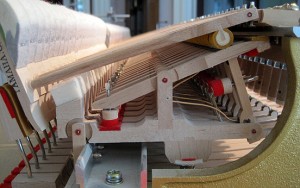
Action Regulation involves the adjustment of the 9000+ working parts in a piano. Keeping these parts adjusted and in good working order is essential to giving you control over the tone and volume of sound that is produced.
As time passes the felts, cloth, and leathers settle, wear, and deteriorate. Wood and wool parts change in size and shape. Metal parts become worn, misaligned, or break. These and other forces conspire to degrade the performance of the instrument and can cause more serious problems. For some, a new piano will need the regulation refined for a higher level of performance.
We include action regulation as a part of your maintenance plan to keep your piano playing its best. Schedule your regulation and begin to love the way your piano plays again.
FAQs – ACTION REGULATION
1. How often does a piano need to be regulated?
Several factors will contribute to the wear of your piano.
- The number of hours and intensity with which the piano is played
- Environmental conditions such as temperature, humidity, and dust
- Quality of the instrument’s design and construction
- Quality of the materials used in the construction
- Demands/expectations of performers
This list is but a few of the factors that impact how often your piano will need to be regulated. Work with your technician and create a maintenance plan that includes periodic regulations. It will keep your piano performing at its best while minimizing unnecessary wear.
2. My technician says the action needs to be rebuilt. Why can’t it just be regulated?
The weights and balances within the dynamics of a moving action are closely related to its design. This is a fancy way of saying, if the parts are worn, the piano will be harder to play and control. No amount of adjusting will compensate for parts that are no longer capable of being in the right place with proper leverage. In some cases, the original design may need to be changed to fix issues that are causing problems.
There are times when the best choice is to update the parts and/or design of the action. We will go through each section of the action, document its parts and relationships, and, if necessary, design an action that will bring you the enjoyment of playing a grand piano.
3. What are the signs my piano needs regulation?
There are very noticeable signs that indicate your instrument needs action regulation.
- A lack of sensitivity or dynamic range.
- Keys that are not level with their neighboring keys throughout the keyboard.
- An uneven or inconsistent touch from one key to the next. (One note sounds loud and the next soft even when using the same touch.)
- A change in the tonal quality.
- Legato passages that sound uneven.
- Chords that sound muddled.
- Subtle phrases that are not so subtle anymore.
We inspect your piano looking for action regulation issues and present you with a plan to remedy the problem(s), giving you the enjoyment of playing a well-regulated piano.
